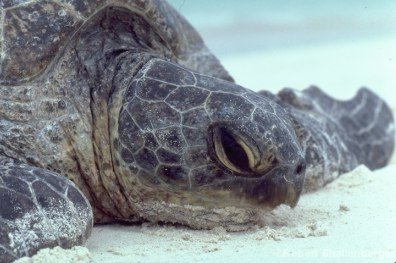|
You
are here: /main/for
teachers /green sea
turtle biology
For
Teachers
Honu
Survivor
The Green Sea Turtle Experience

Green
Sea Turtle. Photo by Rob Shallenberger.
Grades:
3 – 6
Focus
Question: Since approximately 100 turtle eggs hatch per
clutch why are the Green Sea Turtles endangered?
Lesson
at a Glance: Students will participate in discussions
and role-play to learn the hardships of baby Green Sea Turtles.
The students will learn about the low survival rate due to
natural predators and man.
Key
Concepts: They will learn that the survival rate is extremely
low.
Students
will learn how survival until adulthood are affected by natural
predators and humans
Objectives:
The students will be able to:
List the predators of the honu.
State how humans play a part in the turtle's endangerment.
Time:
Two class periods.
Materials:
Paper, pencil, nametags, ropes or cones, string.
Teacher
Background: The Hawaiian Green Sea Turtle, also known
as honu, is an endangered species. In the past, humans killed
them for their meat and shell. The meat was a favorite food
for the Hawaiian Chiefs. The shell was used to make combs,
glasses and jewelry.
Shells
vary in color from black to brown. The Green Sea Turtle gets
it’s name from the green color of it’s fat. Baby
turtles weigh approximately one ounce and are about 2 inches
in length. The adults grow to approximately 400 pounds and
3-4 feet in length. Juvenile turtles are carnivorous and eat
primarily jellyfish. Adult turtles are omnivorous, eating
mainly algae,.
Female
green sea turtles travel, during the summer months, to the
Northwest Hawaiian Islands where they lay eggs in nests. The
female labors at night digging a hole to lay a clutch of approximately
100 eggs resembling rubbery Ping-Pong balls. Sixty days later
the eggs begin to hatch. The baby turtles dig their way out
of the sand. If the sand is too hot they don't leave the nest.
Hot sand signifies day. The hatchlings wait until the sand
becomes cool telling them it is night. When they emerge from
the nest they start towards light. Usually it is the light
reflecting off the ocean. Sometimes the turtles run towards
man made lights, which is a deadly mistake.
Another
man-made hazard for turtles is Marine Debris, which they mistake
for food or in which they become entangled. They also have
natural predators, such as sea birds, sharks, carnivorous
fishes and ghost crabs. Usually there are only one or two
sea turtles that survive out of a clutch.
Preparation
and Procedure:
- Have
a discussion with students. What do they know about the
Green Sea Turtle? Discuss the number of eggs that are hatched
in a clutch and that only one or two turtles survive. Why
are there only one or two survivors? What are the hazards
of being a baby sea turtle?
- Divide
the class in half, for example if you have a class of 30
students make two teams of 15. Name one group predators
and the other Baby honus. Give the students nametags, which
are placed around their necks with string. The nametags
will state what/who they are (example, baby honus, human,
tiger sharks, carnivorous fish, ghost crab, sea birds, marine
debris). You would have 15 honu, 1 tiger shark, 3 sea birds,
1 human, 3 carnivorous fish, 4 ghost crabs and 3 marine
debris.
- Set
up three markers (cones or ropes) in an open area. This
will cut the area into four zones. The left side is the
high tide line where the nest is safe from the surf. The
middle left area is the sand. The middle right is the open
ocean and the right is the seaweed, which is the safe area.
- Place
the honu in the clutch in the high tide zone.
- Place
the birds and the ghost crabs in the beach zone.
- Place
the sharks, carnivorous fish and marine debris in the open
ocean zone.
- Tell
the student that the birds are the only ones that can move
between the beach and the ocean. The honu are to try to
get to the protection of the seaweed. If a predator catches
the honu they must sit down. The predators may catch as
many honu as they can.
- Teacher
begins a dialogue: (To honu) "You have been in your
clutch for 55 days you are almost ready to hatch. Along
comes a person walking on the beach." The student with
the human nametag gets to pick one honu to remove from the
game both students sit down. This signifies how humans can
disturb and destroy turtle nests.
- Teacher
then says, "Five days have passed, the sun has set
and the sand is cool. It is time to leave the nest and head
towards the ocean. I hope you are a survivor."
- The
honu may now head towards the ocean and the safety of the
seaweed.
- After
they finish the dash, they will trade nametags. The honu
will become the predators and the visa versa.
- Debrief
in the classroom. "How many honus survived out of each
group?" "What did you learn?" "How did
you feel when you were turtle/predator?" Were the birds
more successful on the land or the sea? What can humans
do to help? Write of their experience. Explain why the turtles
are endangered.
Extension:
Discussion and or research- Why are the Northwest Islands
the breeding grounds of the Green Sea Turtle? Why don't the
turtles nest closer to civilization? Why do the turtles leave
the nest at night? What may kill green sea turtles after they
are grown?
Created
by the Bishop Museum, 2000.
|